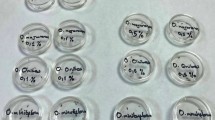Abstract
Human pediculosis is produced by Pediculus humanus humanus (Linnaeus 1758) and Pediculus humanus capitis (De Geer 1767). Laboratory-reared body lice, susceptible to insecticides, were used as reference in toxicological studies on head lice. In this work, we evaluated the survival of both subspecies at different temperatures and relative humidities and we propose the optimal conditions for comparative bioassays. Moreover, we used these conditions to test the activity of three monoterpenoids against both lice. The results showed differential response to changes in temperature and humidity between both organisms. The survival of body lice ranged between 83% and 100% and was not affected for the tested conditions. The survival of head lice depended on temperature, humidity, and exposure time. The optimal conditions for head lice were 18ºC and 97% relative humidity at 18 h of exposition. The insecticidal activity of three monoterpenoids (pulegone, linalool, and 1,8-cineole), evaluated according the selected conditions by topical application, showed no significant differences between males of body and head lice. To conclude, as head lice required more special laboratory conditions than body lice, the optimal head lice conditions should be used in both organisms in comparative bioassays. Body louse is an appropriate organism for testing products against of head louse.



Similar content being viewed by others
References
Abbott WS (1925) A method of computing the effectiveness of an insecticide. J Econ Entomol 18:265–267
Abdel-Ghaffar F, Semmier M (2007) Efficacy of neem seed extract shampoo on head lice of naturally infected human in Egypt. Parasitol Res 100:329–332
Burgess I (1995) Pediculus humanus capitis in schoolchildren. Lancet 345:730–731
Burgess IF (2004) Human lice and their control. Ann Rev Entomol 49:457–481
Burkhart CG, Burkhart CG (2001) Recommendation to standardize pediculicidal and ovicide testing for head lice (Anoplura: Pediculidae). J Med Entomol 38(2):127–129
Buxton PA (1946) The louse: an account of the lice which infest man, their medical importance and control, 2nd edn. Edward Arnold & Co, London
Culpepper GH (1948) Rearing and maintaining a laboratory colony of body lice on rabbits. Am J Trop Med 28:499–504
Downs AMR, Stafford KA, Coles GC (2000) Susceptibility of British head lice, Pediculus capitis, to imidacloprid and fipronil. Med Vet Entomol 14:105–107
González Audino P, Vassena C, Zerba E, Picollo M (2007) Effectiveness of lotions based on essential oils from aromatic plants against permethrin resistant Pediculus humanus capitis. Arch Dermatol Res 299:389–392
Kristensen M, Knorr M, Rasmussen A-M, Jespersen JB (2006) Survey of permethrin and malathion resistance in human head lice populations from Denmark. J Med Entomol 43(3):533–538
Leo NP, Campbell NJH, Yang X, Mumcuoglu K, Barker SC (2002) Evidence from mitochondrial DNA that head lice and body lice of humans (Phthiraptera: Pediculidae) are conspecific. J Med Entomol 39(4):662–666
Leo NP, Hughes JM, Yang X, Poudel SKS, Brogdon WG, Barker SC (2005) The head body lice of humans are genetically distinct (Insecta: Phthiraptera, Pediculidae): evidence from double infestations. Heredity 95:34–40
LeOra Software (1987) POLO-PC: a user’s guide to probit or logit analysis. LeOra Software, Berkeley
Litchfield JT, Wilcoxon F (1949) A simplified method of evaluating dose-effect experiments. J Exp Ther 96:99–110
Mougabure Cueto G, Zerba E, Picollo MI (2006a) Embryonic development of human lice: rearing conditions and susceptibility to spinosad. Mem Inst Oswaldo Cruz, Rio de Janeiro 101(3):257–261
Mougabure Cueto G, Zerba E, Picollo MI (2006b) Permethrin-resistant head lice (Anoplura: Pediculidae) in Argentine are susceptible to spinosad. J Med Entomol 43:634–635
Mougabure Cueto G, Zerba E, Picollo MI (2008) Evidence of pyrethroid resistance in eggs of Pediculus humanus capitis (Phthiraptera: Pediculidae) from Argentina. J Med Entomol 45(4):693–697
Mumcuoglu KY, Miller J, Galum R (1990) Susceptiblity of the human head and body louse, Pediculus humanus (Anolplura: Pediculidae) to insecticides. Insect Sci Appl 11:223–226
Mumcuoglu KY, Friger M, Cohen R (2006) Use of temperature and water immersion to control the human body louse (Anoplura: Pediculidae). J Med Entomol 43(4):723–725
Picollo MI, Vassena CV, Casadio AA, Massimo J, Zerba EN (1998) Laboratory studies of susceptibility and resistance to insecticides in Pediculus capitis (Anoplura: Pediculidae). J Med Entomol 35(5):814–817
Picollo MI, Vassena CV, Mougabure Cueto GA, Vernetti M, Zerba EN (2000) Resistance to insecticides and effect of synergist on permethrin toxicity in Pediculus capitis (Anoplura: Pediculidae) from Buenos Aires. J Med Entomol 37(5):721–725
Priestley CM, Burgess IF, Williamson EM (2006) Lethality of essential oil constituents towards the human louse, Pediculus humanus, and its eggs. Fitoterapia 77:303–309
Toloza AC, Zygadlo J, Mougabure Cueto G, Biurrun F, Zerba E, Picollo MI (2006) Fumigant and repellent properties of essential oils and component compounds against permethin-resistant Pediculus humanus capitis (Anoplura: Pediculidae) from Argentina. J Med Entomol 43(5):889–895
Tomita T, Yaguchi N, Mihara M, Takahashi M, Agui N, Kasai D (2003) Molecular analysis of a para sodium channel gene from pyrethroid-resistant head lice, Pediculus humanus capitis (Anoplura: Pediculidae). J Med Entomol 40(4):468–474
WHO. World Health Organization (1981) Instructions for determining the susceptibility or resistance of body lice and head lice to insecticides. WHO/VBC/81.808. World health Organization, Geneva, Switzerland
Yong Z, Fournier P-E, Rydkina E, Raoult D (2003) The geographical segregation of human lice preceded that of Pediculus humanus capitis and Pediculus humanus humanus. C R Biologies 326:565–574
Author information
Authors and Affiliations
Corresponding author
Rights and permissions
About this article
Cite this article
Gallardo, A., Mougabure Cueto, G. & Picollo, M.I. Pediculus humanus capitis (head lice) and Pediculus humanus humanus (body lice): response to laboratory temperature and humidity and susceptibility to monoterpenoids. Parasitol Res 105, 163–167 (2009). https://doi.org/10.1007/s00436-009-1378-0
Received:
Accepted:
Published:
Issue Date:
DOI: https://doi.org/10.1007/s00436-009-1378-0




